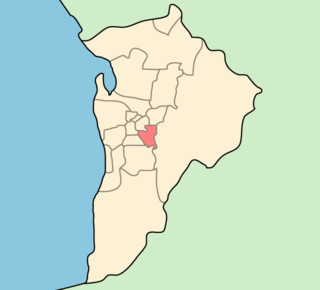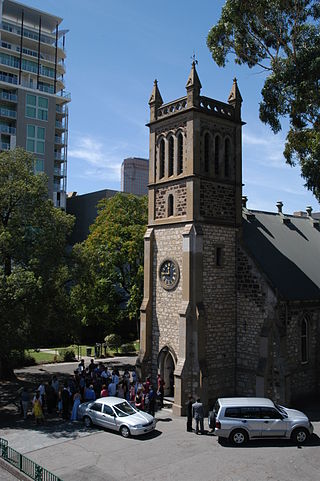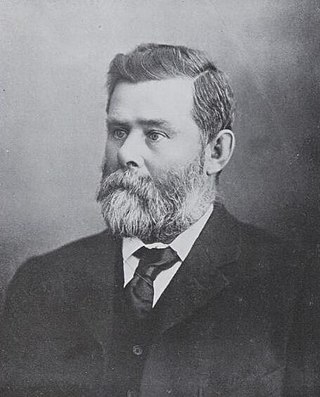
Norwood is a suburb of Adelaide, about 4 km (2.5 mi) east of the Adelaide city centre. The suburb is in the City of Norwood Payneham & St Peters, whose predecessor was the oldest South Australian local government municipality.

The City of Burnside is a local government area in the South Australian city of Adelaide stretching from the Adelaide Parklands into the Adelaide foothills with an area of 2,753 hectares. It was founded in August 1856 as the District Council of Burnside, the name of a property of an early settler, and was classed as a city in 1943. The LGA is bounded by Adelaide, Adelaide Hills Council, Campbelltown, Mitcham, Norwood Payneham and St Peters and Unley.

Trinity Church Adelaide, formerly known as Holy Trinity Church and later Trinity City, is an Australian evangelical Anglican church located at 88 North Terrace in the city of Adelaide, South Australia. Established in 1836, it is one of the earliest churches in the colony of South Australia.
Wheal Watkins mine, formerly Wheal Gawler mine, is an historic lead and silver mine in Glen Osmond, South Australia. The mine first operated from 1844 until 1850, and again briefly in 1888 to 1889, and 1916. From 1986 onwards, the mine was accessible by guided tour, until a rockfall event prompted its closure in 2005.
Frewville is a small suburb in the South Australian city of Adelaide. It is three kilometres south-east of Adelaide's central business district (CBD).

Parkside is an inner southern suburb of Adelaide, South Australia. It is located in the City of Unley.
Fullarton is an inner southern suburb of Adelaide, South Australia in the City of Unley.
Marryatville is a small suburb about 4–5 kilometres (2.5–3.1 mi) east of Adelaide's central business district, in the local council area of City of Norwood Payneham St Peters. Comprising low- to medium-density housing, two large schools, a church and several shops, it also has two creeks running through it. The first European settler on the land was George Brunskill in 1839, with part of the land purchased and laid out as a village in 1848 by James Philcox.

The history of the City of Burnside, a local government area in the metropolitan area of Adelaide, spans three centuries. Prior to European settlement Burnside was inhabited by the Kaurna people, who lived around the creeks of the River Torrens during the winter and in the Adelaide Hills during the summer.

Cross Road is a major arterial road that travels east–west through the inner southern suburbs of the Australian city of Adelaide. It is designated route A3.

Glen Osmond Road is a major section of the Princes Highway in the city of Adelaide, South Australia. Connecting the Adelaide city centre with the Adelaide Hills via the South Eastern Freeway; Glen Osmond Road carries half of Adelaide's freight traffic and is the major commuter route from the southern Adelaide Hills. It is designated part of route A1.
A. M. Bickford and Sons was one of the first manufacturing chemists in South Australia. Until 1930, it was one of the State's most significant family-owned companies. In 1930, they amalgamated with half a dozen other similar Australian companies to form "Drug Houses of Australia" (DHA), which continued to produce "A. M. Bickford and Sons" products: "drugs" and "chemicals" under the DHA brand; and cordials and soft drinks under the "A. M. Bickford and Sons" brand.

George Swan Fowler was a South Australian politician and a Treasurer of South Australia.
Rev. William Henry Mudie was an Anglican priest and educator in Adelaide, South Australia.

John Lewis was an Australian pastoralist and politician. He was a member of the South Australian Legislative Council from 1898 to 1923, representing the Northern District (1898-1902) and North-Eastern District (1902-1923). He was the father of Essington Lewis.
William Murray was a pioneering gardener of South Australia.

The City of Kensington and Norwood, originally the Corporate Town of Kensington and Norwood, was a local government area in South Australia from 1853 to 1997, centred on the inner eastern Adelaide suburbs of Kensington and Norwood. In November 1997 it amalgamated with the City of Payneham and the Town of St Peters to form the City of Norwood Payneham & St Peters.
William Ferguson was a pioneer settler of South Australia, one of the last surviving emigrants on HMS Buffalo in 1836.
Keswick Creek and Glen Osmond Creek together form a watercourse flowing through the inner south-eastern, south-western and western suburbs of the Adelaide metropolitan area, in the Australian state of South Australia. The watercourse is part of the Patawalonga River catchment.


















